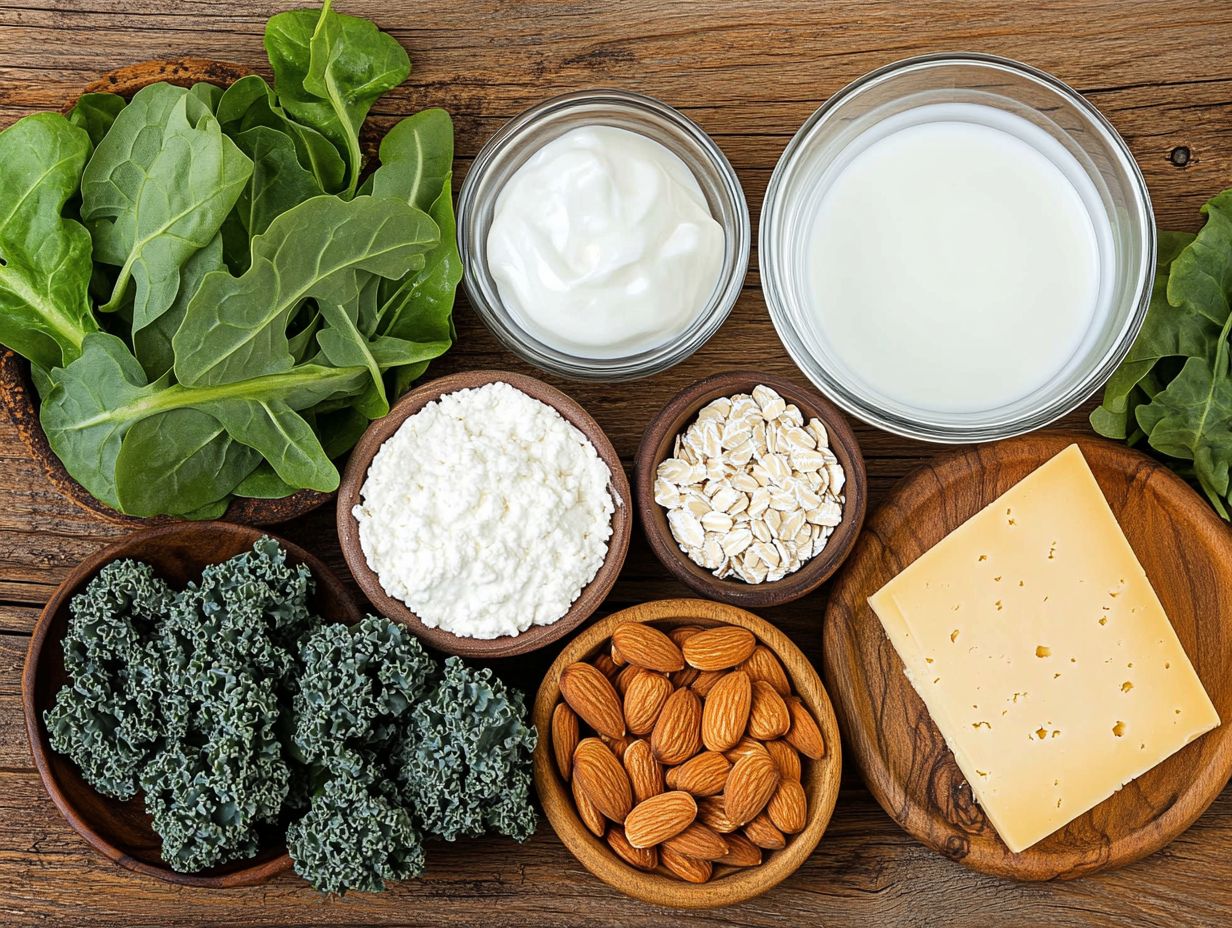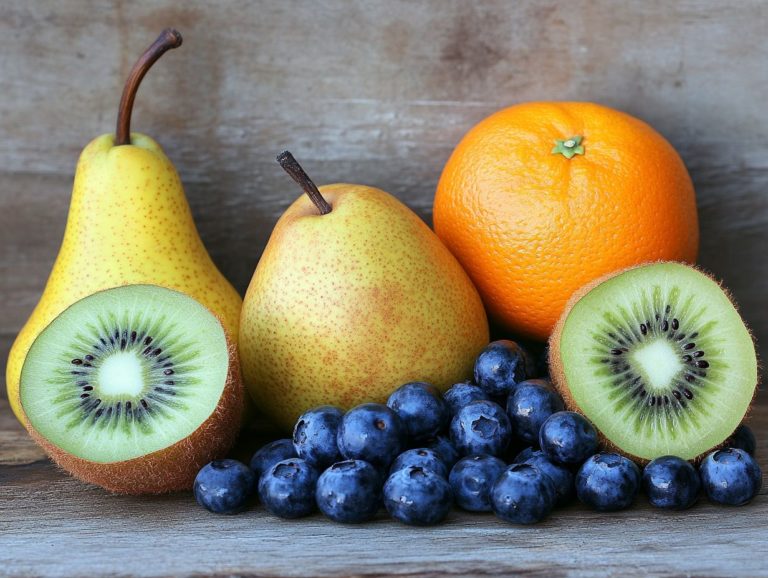Calcium-Rich Foods: What to Include in Your Diet
Calcium is essential for good health. It helps with bone strength and muscle function, but it s easy to overlook this mineral in your daily diet.
This article explores the vital roles calcium plays in your body. It highlights delicious calcium-rich foods to add to your meals and practical tips to ensure you get enough of this nutrient.
You’ll also learn about the risks of calcium deficiency and when supplements might be necessary. Whether you want to improve your diet or understand calcium better, this guide is for you.
Contents
- Key Takeaways:
- Why Calcium is Important for Your Health
- Calcium-Rich Foods to Include in Your Diet
- Ways to Incorporate Calcium into Your Meals
- Supplements for Calcium Intake
- Potential Risks of Calcium Deficiency
- Frequently Asked Questions
- Looking for calcium-rich foods? Here are some tasty options!
- What are some examples of calcium-rich foods?
- How much calcium should I be getting in my diet?
- Can I get enough calcium from plant-based sources?
- How can I incorporate more calcium-rich foods into my diet?
- Can I take calcium supplements instead of eating calcium-rich foods?
Key Takeaways:

Calcium is crucial for strong bones, nerve function, muscle function, and blood clotting. Include dairy, green leafy vegetables, fish, and fortified foods in your diet to meet daily calcium needs. Supplements may help if you struggle to get enough from food.
Why Calcium is Important for Your Health
Calcium is vital for your overall health and bone health. It acts as a building block for strong bones.
Calcium also supports muscle function and body functions. It helps maintain blood pressure and promote heart health.
Getting enough calcium is linked to a lower risk of osteoporosis, which can weaken bones. Prioritize calcium-rich foods and consider supplements to meet your needs.
Your health deserves this attention!
The Role of Calcium in the Body
Calcium plays key roles in your body. It contributes to strong bones and facilitates muscle and cellular functions.
This mineral is essential for muscle contractions. It helps your muscles work effectively when stimulated by nerve signals.
Calcium also aids in nerve function. It helps transmit signals through your nervous system, which is crucial for coordination.
It plays a significant role in blood clotting. Calcium works with different proteins to ensure wounds heal properly.
Don’t forget about vitamin D! It helps your body absorb calcium, which is crucial for preventing deficiencies and maintaining good health.
Calcium-Rich Foods to Include in Your Diet
Take charge of your health! Include these calcium-rich foods in your meals:
- Dairy products
- Green leafy vegetables
- Nutrient-rich fish
- Fortified foods
These options will help you easily meet your daily calcium needs.
Dairy Products
Dairy products, like milk, yogurt, and cheese, are among the richest sources of calcium. They provide essential nutrients for bone health and help prevent osteoporosis.
A cup of milk has about 300 mg of calcium. A serving of yogurt can offer even more, depending on the type. Hard cheeses like parmesan can deliver over 800 mg of calcium per ounce.
If you’re lactose intolerant, try lactose-free milk or fortified plant-based options. You can still support your bone health while avoiding discomfort.
Green Leafy Vegetables

Green leafy vegetables, like collard greens and kale, are great sources of calcium, providing a nutritious alternative for anyone leaning toward a plant-based diet. These vibrant greens also help meet your daily calcium requirements and offer high levels of vitamins A, C, and K, essential for a strong immune system and healthy skin.
Incorporating these veggies into your meals is fun and easy! Toss them into salads, blend them into smoothies, or saut them as a delightful side dish.
The calcium found in these leafy greens is best absorbed when paired with vitamin D-rich foods, highlighting their essential role in enhancing overall nutrient uptake. By regularly including them in your diet, you can effectively support your bone health and achieve a balanced nutritional value.
Fish and Seafood
Fish and seafood, especially choices like salmon and sardines, are not just delightful on the palate; they are powerhouses of omega-3 fatty acids and significant sources of calcium. This makes them essential to your balanced diet.
Don t overlook other excellent options like anchovies and mackerel, which also contribute impressive calcium levels for robust bone health and overall well-being.
Preparing these fish is both simple and flavorful. Imagine grilling salmon with fresh herbs or crafting a hearty stew with canned sardines both elevate your meals while enhancing their nutritional value.
These fish are also rich in protein and essential vitamins like B12, vital for maintaining energy levels and sharp cognitive function.
Regularly incorporating fish into your meals not only boosts your calcium intake but also plays a crucial role in reducing the risk of chronic diseases. Don’t wait to enhance your health start adding fish to your diet today!
Fortified Foods
Fortified foods, such as select cereals and plant-based milks, present an exceptional opportunity to elevate your calcium intake, especially if dairy isn’t part of your diet. These products undergo enrichment during processing, ensuring that each serving has a higher concentration of calcium.
For example, almond and soy milks are often fortified with both calcium and vitamin D, enhancing not just their nutrient value but also bolstering your bone health. You might also consider options like fortified orange juice and breakfast bars, which serve as convenient sources of calcium.
By incorporating these fortified items into your daily nutrition, you can effectively avoid not getting enough calcium, a key element in maintaining robust bones and overall well-being.
Ways to Incorporate Calcium into Your Meals
Incorporating calcium into your meals can be seamless and delightful. Boosting your calcium intake can be delicious and simple with a selection of delectable recipes and thoughtful meal planning strategies.
Recipe Ideas and Tips
Simple recipe ideas, like smoothies made with yogurt and leafy greens or almond-based snacks, can easily enhance your calcium intake while tantalizing your taste buds.
Exploring a diverse array of meals that spotlight calcium-rich ingredients transforms nutrition into an enjoyable experience. For instance, when you add fortified plant-based milk into your cereals or oatmeal, you not only enhance the creamy texture but also infuse essential nutrients.
If you re looking to adapt your diet, consider swapping standard pasta for whole grain or lentil varieties for a hearty, calcium-packed meal.
Taking dietary preferences into account is key; accommodating vegan, vegetarian, or lactose-intolerant lifestyles can be simple. By substituting dairy products with alternatives like tofu or chia seeds, you can maintain both flavor and nutritional balance, enjoying every bite!
Supplements for Calcium Intake

For many people, incorporating calcium supplements can become essential to meet daily calcium needs. This is particularly true if dietary sources fall short or if there are concerns about problems absorbing nutrients.
When and How to Take Calcium Supplements
Knowing when and how to take calcium supplements boosts their effectiveness, improving calcium absorption and maximizing health benefits.
Choosing the right timing is crucial. Calcium is often best absorbed when taken with food. This approach enhances its interaction with essential nutrients like vitamin D, which is vital for calcium metabolism.
Taking calcium on an empty stomach might cause gastrointestinal discomfort and lower absorption rates. It s also important to be mindful of interactions with other minerals, like iron and zinc, which can compete with calcium.
By following the recommended dosage typically around 1,000 to 1,200 mg for most adults you can ensure optimal health while minimizing the risk of adverse effects.
Potential Risks of Calcium Deficiency
A calcium deficiency can have serious health repercussions, including an increased risk of weak bones and kidney stones.
It’s vital to identify the signs early and adopt effective prevention strategies to safeguard your health. Prioritizing calcium intake is essential for maintaining your well-being and preventing serious conditions.
Health Consequences and Prevention Strategies
Health issues from calcium deficiency can be significant, leading to weak bones and even the formation of kidney stones. This highlights how crucial it is to take preventive action.
Low calcium levels can also cause muscle spasms, numbness, and tingling sensations, disrupting your daily life.
To combat these health risks, think about adding calcium-rich foods to your diet, such as:
- Leafy greens
- Dairy products
- Almonds
- Fortified plant-based milk
Incorporating regular weight-bearing exercises can significantly strengthen your bones and enhance calcium absorption. Don t forget, ensuring adequate vitamin D levels through sun exposure or dietary sources is essential for maximizing calcium uptake. This supports your overall health.
Frequently Asked Questions
Looking for calcium-rich foods? Here are some tasty options!

Calcium-rich foods are those containing high levels of calcium, a mineral essential for building and maintaining strong bones and teeth. Calcium also supports muscle contraction and nerve transmission.
What are some examples of calcium-rich foods?
Dairy products like milk, cheese, and yogurt are well-known sources of calcium. Other good sources include leafy green vegetables, fortified cereals, tofu, almonds, and sardines.
How much calcium should I be getting in my diet?
The recommended daily intake of calcium varies by age and gender. For adults, it s 1,000 milligrams per day; for women over 50 and men over 70, the recommendation increases to 1,200 milligrams per day.
Can I get enough calcium from plant-based sources?
Yes, you can get sufficient calcium from a plant-based diet. Many plant-based foods, like leafy greens, are high in calcium. Additionally, many fortified plant-based products, such as non-dairy milks, contain added calcium.
How can I incorporate more calcium-rich foods into my diet?
There are plenty of ways to add more calcium-rich foods to your meals. Consider adding cheese to salads or sandwiches, tossing leafy greens into smoothies, snacking on almonds or sardines, or incorporating tofu into stir-fries or curries.
Can I take calcium supplements instead of eating calcium-rich foods?
While calcium supplements can be beneficial, it’s still important to include calcium-rich foods in your diet. Whole foods provide a variety of nutrients, while supplements offer just one. It s best to consult a healthcare professional before starting any new supplement regimen.
Start including these calcium-rich foods in your meals today for better health!






